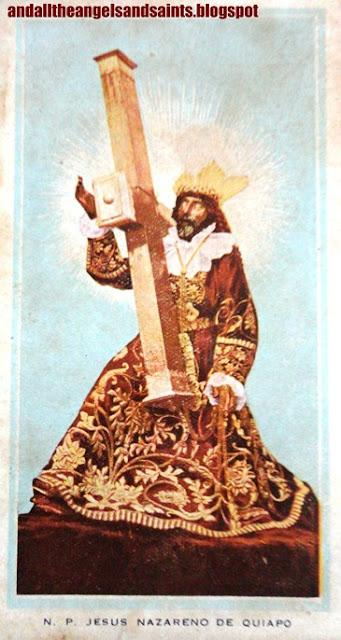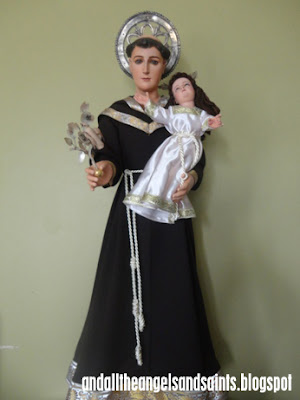In one of my recent antiquing weekends last June, I decided to drive to Apalit and check out the stuff of a dealer there, fairly new in town. I had not realize that it was the town’s fiesta week, and I was caught in a massive traffic jam that resulted in a trip of more than an hour! Of course, upon arriving, I chided the dealer for not warning me of Apu Iro’s (St. Peter, the town patron)
fiesta, and she retorted that had she done, I wouldn’t have come. What a clever ruse!
She appeased me with fiesta food, all laid out on her table, while she took out her items for me to see, not much really---ceramics, vintage paintings, kitchen collectibles. I bought a few Chinese
achara pots, but there was nothing much of interest for me.
With a sigh, I was all set to depart, but then, the dealer suddenly remembered a
santo that she had stashed upstairs, plus a few other religious articles. When her helper brought them down, I became excited by what I saw.
It was a 36 in, San Antonio on a 5 inch base, classically carved, complete with a bald Niño, similarly carved in the same refined style.
Saint Anthony of Padua, Italy was a popular saint in the country, introduced early by Franciscan missionaries. It was said that the Child Jesus appeared to him, hence the representation. Only 36 tears old when he died, he was canonized a year just after his death. Today, he is commonly referred as a "finder of lost articles".
San Antonio was in a bad state, with one arm missing and without hands. At one time, the saint must have held a sprig of lilies—symbols of purity--perhaps carved separately to be held by his right hand. The Niño’s condition was much better, its joints intact, with just a few broken fingers.
The images had been repainted several times in the past, and when I got them, their bodies were painted pink, their faces, in ashen flesh color.
San Antonio was missing his halo, while the Child Jesus had lost his wig. There were no indications in the head that he wore
potencias.
Both heads, however, were handsomely carved, and I estimated to be anywhere from 60-70 years old, early post-war pieces, perhaps.
I have missed out on a few large images of San Antonio in the past, so I made sure that this one goes home with me.
Because of the flaws of the carvings, I managed to wrangle a big discount from my dealer. Not only did I got to take these
santos home, but also an 8 in. antique wooden sleeping Nativity Niño!
I was so eager to have these images restored that I didn’t even bother checking the schedule of santo restorer, Dr. Raffy Lopez. He was in the midst of moving things into his new house, but I brought the santos to him anyway, barely a week after purchasing them. Knowing I will never take “no”for an answer, he went ahead and accepted this restoration project.
Initially, my project brief included giving San Antonio a swarthy complexion, complete with 5 o’clock shadow, but thank God I changed my mind. Since I was on a shoestring budget, I asked Dr. Lopez to outfit him in an austere dark brown hooded habit, with simple gold trims on the hems and sleeves. I had no idea what the Niño would wear, so I pretty much left this to the good doctor to decide.
The restoration process began almost immediately.
Lopez brought the santo to his contracted carver who made new hands and attached new arms for San Antonio. Niño’s fingers were mended in no time at all.
The
encarna painting itself was done in several stages but I was pretty much kept in the loop with regular phone messaging updates.
It was during this stage of the restoration that we made a stunning discovery about this
santo’s provenance. When the painter finished stripping the old paint done on the base, a small brass plaque appeared on the upper right hand corner. The plaque was just the size of a small postage stamp, but when it was further cleaned, the letters in relief became more apparent, revealing the name and address of the original maker:
TALLER DE IRINEO M. CRISTOBAL. Evangelista, Manila, P.I.
This then is the handiwork of the famed santero from Quiapo who was active in the creation of religious statuaries from the 20s to the 50s. Irineo M. Cristobal, one of the more popular commercial
santeros who followed Maximo Vicente, established his own talyer in the
santo carving district of Manila—along Evangelista Street in Quiapo.
A month after, I was ready to bring San Antonio home. He now wears a beautiful habit complete with the trademark Franciscan cord. The Child Jesus, in appropriate ”goldilocks” wig is vested in a plain vintage satin tunic, also corded at the waist.
I was pleased with the way he was restored, but even happier knowing that I have a treasure in my hand—a Cristobal creation, no less—just the second image in my collection with known and proven provenance.
Dr. Lopez managed to find a vintage 8 inch halo, which fitted him perfectly—this, after my own fruitless search in thrift shops and antique shops. He did better than that by finding a set of
potencias of the right size, in the last minute!
To give a sense of completeness, I let the santo hold a stem of antique flowers made from mother of pearl (
lagang), and then made these photographs.
But on the day I was to take the santo home, a friend gifted me with this handcrafted spray of lilies—an attribute of the saint—made also from mother-of-pearl shells!! Will wonders never cease??
So this then is the finished San Antonio de Padua with Niño Jesus by Irineo M. Cristobal—an affordable find that has become my find of the year! Now this calls for my own
fiesta celebration!!

























































